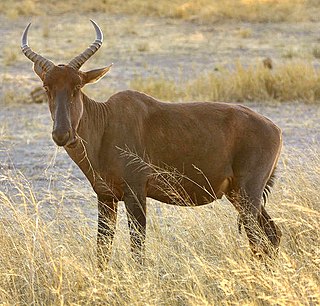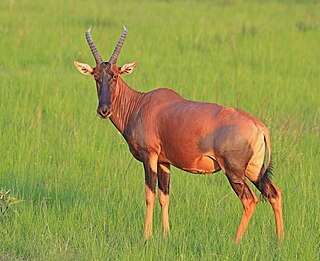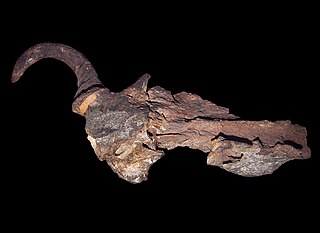 W
WThe subfamily Alcelaphinae of the family Bovidae contains wildebeest, hartebeest, bonteboks, and several similar species. Depending on the classification, there are 6-10 species placed in four genera, although Beatragus is sometimes considered a subgenus of Damaliscus, and Sigmoceros for the Lichtenstein's hartebeest.
 W
WThe hirola, Hunter's hartebeest or Hunter's antelope, is a critically endangered antelope species found on the border between Kenya and Somalia. They were discovered by the big game hunter and zoologist H.C.V. Hunter in 1888. It is the only member of the genus Beatragus. The global hirola population is estimated at 300–500 animals and there are none in captivity. According a document produced by the International Union for Conservation of Nature "the loss of the hirola would be the first extinction of a mammalian genus on mainland Africa in modern human history".
 W
WThe black wildebeest or white-tailed gnu is one of the two closely related wildebeest species. It is a member of the genus Connochaetes and family Bovidae. It was first described in 1780 by Eberhard August Wilhelm von Zimmermann. The black wildebeest is typically 170–220 cm (67–87 in) in head-and-body length, and the typical weight is 110–180 kg (240–400 lb). Males stand about 111–121 cm (44–48 in) at the shoulder, while the height of the females is 106–116 cm (42–46 in). The black wildebeest is characterised by its white, long, horse-like tail. It also has a dark brown to black coat and long, dark-coloured hair between its forelegs and under its belly.
 W
WThe blue wildebeest, also called the common wildebeest, white-bearded wildebeest, or brindled gnu, is a large antelope and one of the two species of wildebeest. It is placed in the genus Connochaetes and family Bovidae, and has a close taxonomic relationship with the black wildebeest. The blue wildebeest is known to have five subspecies. This broad-shouldered antelope has a muscular, front-heavy appearance, with a distinctive, robust muzzle. Young blue wildebeest are born tawny brown, and begin to take on their adult coloration at the age of 2 months. The adults' hues range from a deep slate or bluish-gray to light gray or even grayish-brown. Both sexes possess a pair of large curved horns.
 W
WThe wildebeest, also called the gnu, is an antelope in the genus Connochaetes. It belongs to the family Bovidae, which includes antelopes, cattle, goats, sheep, and other even-toed horned ungulates. Connochaetes includes two species, both native to Africa: the black wildebeest or white-tailed gnu, and the blue wildebeest or brindled gnu.
 W
WDamaliscus, commonly known as tsessebes, is a genus of antelope in the family Bovidae, subfamily Alcelaphinae, found in Africa.
 W
WDamalops is an extinct genus of Alcelaphinae. It lived during the Pleistocene in southern Asia, where the species Damalops palaeindicus is known from the Siwaliks in the northern part of the Indian Subcontinent.
 W
WThe hirola, Hunter's hartebeest or Hunter's antelope, is a critically endangered antelope species found on the border between Kenya and Somalia. They were discovered by the big game hunter and zoologist H.C.V. Hunter in 1888. It is the only member of the genus Beatragus. The global hirola population is estimated at 300–500 animals and there are none in captivity. According a document produced by the International Union for Conservation of Nature "the loss of the hirola would be the first extinction of a mammalian genus on mainland Africa in modern human history".
 W
WMegalotragus was a genus of very large extinct African alcelaphines that occurred from the Pliocene to early Holocene. It resembled modern hartebeests, but differed in larger body size, it includes the largest bovids in the tribe Alcelaphini, reaching a shoulder height of 1.4 m (4.6 ft). The genus consists of three species of which Megalotragus priscus survived until the early Holocene 7.500 C14yBP.
 W
WThe wildebeest, also called the gnu, is an antelope in the genus Connochaetes. It belongs to the family Bovidae, which includes antelopes, cattle, goats, sheep, and other even-toed horned ungulates. Connochaetes includes two species, both native to Africa: the black wildebeest or white-tailed gnu, and the blue wildebeest or brindled gnu.